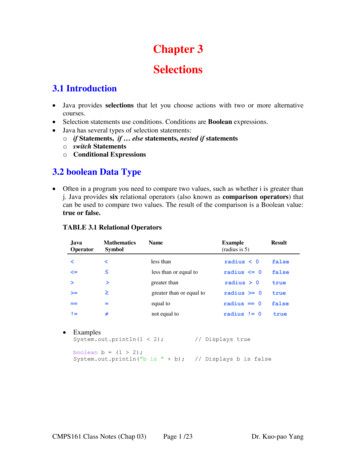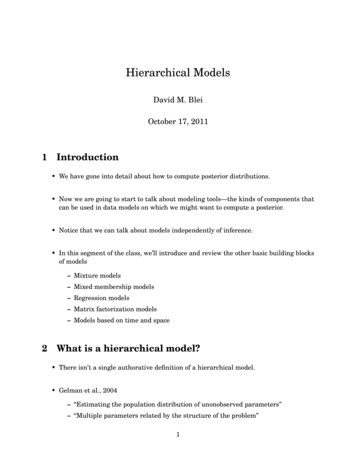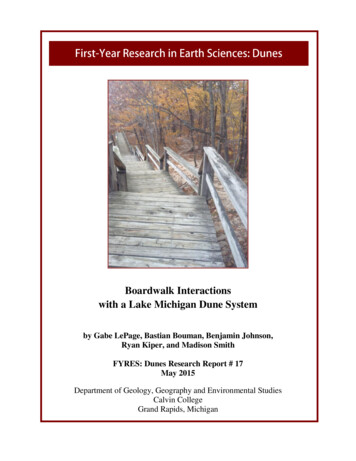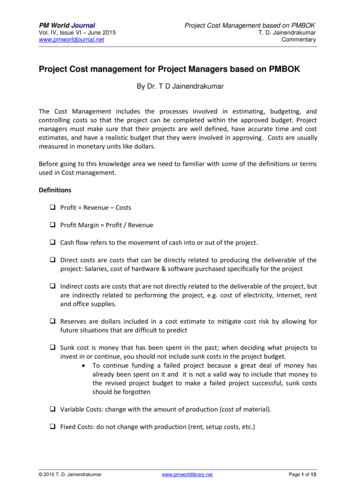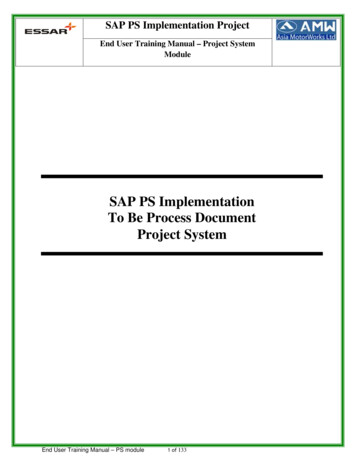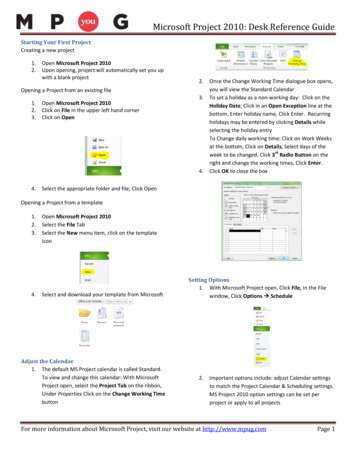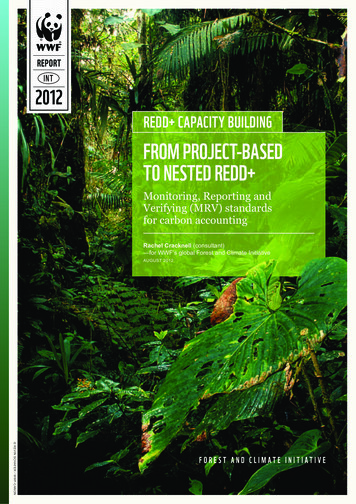
Transcription
REPORTINT2012REDD CAPACITY BUILDINGFROM PROJECT-BASEDTO NESTED REDD Monitoring, Reporting andVerifying (MRV) standardsfor carbon accountingRachel Cracknell (consultant)—for WWF’s global Forest and Climate InitiativeAUGUST 2012 KEVIN SCHAFER / WWF-CANON
IN THIS ISSUEEXECUTIVE SUMMARY . 11. INTRODUCTION . 22. SUMMARY OF KEY FINDINGS . 43. SUMMARY OF SUPPORTING LITERATURE .124. WAY FORWARD .22
Executive summaryEXECUTIVE SUMMARYConsensus has been reached in climate negotiations that carbon emissionsassociated with Reducing Emissions from Deforestation and ForestDegradation (REDD ) will be monitored and recorded based on nationallevel accounting systems. However, sub-national initiatives, especially atthe project level, are rapidly evolving and are already being implementedin many countries. Determining ways to integrate these two differentaccounting systems and scales, i.e., generating “nested” approaches,is thus integral to the future success of a global REDD mechanism.In recognition of this challenge,this short report seeks to determinewhich of the existing standards for themonitoring, reporting and verification(MRV) of carbon emissions associatedwith REDD activities are mostappropriate for use within a nestedsystem. Furthermore, the report seeksto uncover and highlight key issuesthat all project managers developingREDD projects should considerwhen developing sub-national REDD projects. To achieve this goal theauthor has undertaken both aliterature review and a series ofkey stakeholder interviews. The key findings of the researchare as follows: COP 17 mandated that referenceemissions levels for nationalREDD emissions reporting shouldbe calculated using the most recentIntergovernmental Panel onClimate Change (IPCC) guidelines,and thus all REDD projectsshould ensure that they complywith these guidelines to allowfor future nesting. When developing project-basedMRV systems, the national REDD strategy and context should betaken into consideration to ensurethat the projects are set up to beeasily integrated into a futurenested system.If there is a lack of national MRVguidelines to comply with, theVerified Carbon Standard (VCS)currently provides the most usefulstandard for MRV in REDD ,but its detailed methodologicalrequirements provide significanthindrances. VCS is recommendedfor use, but only if it gives arealistic and feasible means ofconforming with the IPCC 2006guidelines. Where this is notpossible, other guidelines suchas the GOLF-GOLD source bookshould be referenced.Governments should be consultedas stakeholders when setting upproject-based MRV activities.Dialogue needs to be establishedand formalized between field levelprojects and the jurisdictional ornational level to ensure thatactivities are complementary andthat progress is made in parallel. Simplicity in developing MRVsystems is important. This helpsto reduce costs and make projectsmore profitable. Feasibility and cost benefit analysesshould be undertaken before anyREDD project is initiated. Thiswill help define the MRV systemput in place. The World Bank’straining manual on opportunitycosts is a useful document toconsult in undertaking thisassessment. The drivers of deforestation anddegradation will help to definethe MRV system required. Capacity development is neededto support governments in buildinga central REDD coordinating bodythat can set out MRV criteria andsubsequently implement nationaland nested REDD . Capacity development is alsorequired to support informationsystem management, to ensurethat data is effectively collectedand stored in databases for use innested and national MRV systems.1
From project-based to nested REDD: MRV standards for carbon accounting1.0INTRODUCTIONonsensus has been reachedin climate negotiations thatemissions associated withREDD will be monitored andrecorded based on national-levelaccounting systems. However,sub-national initiatives, especiallyat the project level, are rapidlyevolving and are already beingimplemented in many countries.Determining ways to integrate thesetwo different accounting systemsand scales, i.e., generating “nested”approaches, is thus integral to thefuture success of a global REDD mechanism.CIn recognition of this challenge,there is a specific need to understandhow the project-level monitoring,reporting and verification (MRV)of carbon emissions reductionsassociated with the majority ofexisting REDD projects can beintegrated with future nationalreporting frameworks. This is notonly important for the future successof REDD but also relevant today,as project managers need to ensurethat when they are developingREDD projects, they take heedof how future reporting mechanismswill likely take shape.2This short report investigates thisissue through both a literature reviewand a summary of the findings froma series of interviews with keystakeholders both internal andexternal to WWF. The report’s goal isto gain an overarching picture of thedifferent perspectives of standardsused for MRV and applied to REDD ,as reporting moves from a projectbased framework to a more nestedor national approach.Interviews were held with a varietyof experts, including: technical andMRV experts from large conservationNGOs and the World Bank, individualsinvolved in the development ofvoluntary standards including theVerified Carbon Standard (VCS)and the Climate Community andBiodiversity Alliance’s (CCBA)voluntary standard, as well as WWFproject managers for REDD projectsbased in a variety of countries.While the key goal of the research wasto gain a picture of which standardsfor MRV are most appropriate for usewithin a nested approach to REDD ,several specific research questionswere also addressed. These includedgaining an understanding of thechallenges of applying existing MRVstandards, determining how fundsshould be allocated within a nestedsystem, and defining the overarchingsocial and political issues that needto be considered.A summary of the key findings fromthe interviews has been presented inchapter 2. Chapter 3 provides a shortliterature review to determine if thefindings from the interviews can besupported by common thinking inacademia and among internationalinstitutions. Taking forward thecommentary and findings in chapters2 and 3, recommendations for projectmanagers are provided in chapter 4,along with next steps for furtherresearch.
WWF-CANON / SIMON RAWLES3
From project-based to nested REDD: MRV standards for carbon accounting2.0SUMMARY OF KEY FINDINGShis chapter summarizes thekey findings from a numberof stakeholder interviews.Individuals were interviewedfrom a range of organizationsincluding both technical and MRVexperts from large conservationNGOs, the World Bank and individualsinvolved in the development ofvoluntary standards including VCSand CCBA, as well as WWF projectmanagers for REDD projects basedin a variety of countries.TPlease note that the content of thischapter reflects the collective responsefrom the interviewees, and theinformation should be regarded inparallel with the literature reviewsummarized in chapter 3. Finally,the key findings from both chapters 2and 3 are drawn together in chapter 4,along with a recommended wayforward.2.1WHICH STANDARDIS THE MOST APPROPRIATEFOR CARBON MRVIN NESTED REDD ?There was general agreement amongthe interviewees that no one standardwill be applicable to all countrieswithin a nested or sub-national REDD framework. Moreover, the only actualstandard for carbon-related MRVbeing used within REDD projectsamong the interviewees was the VCS’sstandard. Within WWF, existingpolicy states that the VCS should beused for REDD in conjunction withthe CCBA’s standard to account forsocial and environmental safeguards.Outside WWF, the VCS standardwas also deemed the most robustand appropriate standard for carbonaccounting in REDD projects, andagain was typically applied with theCCBA’s standard. However, not allprojects involving MRV systemswere being set up to comply withthis standard.On review of the interviews, threeapproaches emerged in terms of MRV:complying with the VCS and CCBA,developing a “best practices” MRV,and “lowering the bar” by usingsimple and easy methods. Theseapproaches are detailed below.42.1.1Complying with VCS and CCBAIn terms of using standards for MRVwithin REDD , VCS and CCBA werethe only two standards mentionedby those interviewed. VCS is beingused to develop an assessment ofthe carbon emissions associated withREDD , and the CCBA is being usedto ensure that social and environmentalsafeguards are met.The key reason noted for using theVCS’s standard was the organization’sgood reputation—thus buyers wantto buy VCS credits as they are seenas being robust and credible.Obtaining buyers is a critical concernfor projects applying certificationstandards, because with no buyers,the view is that there is no value incertification. There is a trade-offto this, though: VCS certificationis very costly, time-consumingand data-intensive.While many are currently applyingVCS’s MRV systems to REDD projects, a number of key issueswere raised in relation to the system’sapplicability at the sub-nationalor nested level. These included theonerous methodological requirementsof the VCS standard and the fact thatthere are currently not many methodsavailable under the standard. Thosethat have been developed are specificto a certain project case, and if a newproject differs even just a little bitfrom the existing methods, the projectmanagers must update and rewritethe affected method steps andundergo a double approval process.It is thus difficult and costly to starta project that doesn’t already havea methodology that fits. Others
Summary of Key Findingscommented that VCS was verycomplex and complicated, and thatit is hard to combine the requiredtechnical accuracy with the reality ofwhat the project can achieve, especiallyin developing countries. Others stillnoted the difficulties of up-scalingthe technical requirements of VCSmethodologies. For example, VCSreference areas need to be similarand uniform when compared to theproject area in order to assess projectbaselines and potential leakage. Thisbecomes a problem when REDD isscaled up, as it is not possible to findappropriate reference areas and atthe national level finding referenceareas becomes rather impossible.Of importance to this research is thefact that VCS has recently started theprocess of developing a new standard,the “jurisdictional and nested REDD standard” (JRNI), which has the goalof providing an integrated accountingframework for crediting REDD projects, policies and programs acrossstates, provinces or nations. Thecompleted development of the JRNIstandard is likely to be a few yearsaway. VCS has also set up an initiativeto look at standardizing approaches tosetting baselines and determiningadditionality that does not need abaseline per se, but instead uses aperformance benchmark (if youperform better than a threshold thenyou can gain credits and be rewarded).This effort is linked to the JRNIinitiative, but has been kept separateso that it can be integrated intojurisdictional and nested projects,and is also currently undergoing aformal consultation process. Giventhese initiatives, it is likely that theVCS standard will become moreapplicable to MRV for nested REDD projects in the future.2.1.2Best-practices MRVSome stakeholders are developingMRV systems that do not complywith a reporting standard but insteadrepresent best practices: the highestgrade methodologies possible forcarbon accounting. The goal is todevelop systems that can be usedas proof-of-concept demonstrations.These projects are generally notintended for the voluntary marketbut are instead intended to attractfinancing from international systemsor bilateral funds. MRV best practicesmeet the need for demonstrationprojects showing how REDD canbe pulled off on a larger scale. EDWARD PARKER / WWF-CANON5
From project-based to nested REDD: MRV standards for carbon accounting“ REQUIREMENTSFOR MRV STANDARDSWILL ULTIMATELY BEDRIVEN BY THE MARKET,AS A VALIDATIONOF INVESTMENT.”2.1.3Simply “lowering the bar”A third approach discussed byinterviewees was a simplified MRVsystem. Such an approach can helpmake REDD projects more financiallyfeasible, thanks to the reduced timeand costs required for developing theMRV system, setting up the projectand achieving certification. This isespecially relevant in a climate wherethe rate of financial return has not beenproven when investing in the development of large-scale, complicated andexpensive REDD projects. A “loweringthe bar” approach to MRV, however,can be criticized for ignoring the factthat better data may be available andmay provide an inaccurate estimateof carbon emissions. Nonetheless, theaccusation of inaccuracy may not bevalid. When you consider the multiplication effect of the uncertaintiesinvolved in developing detailedmethodologies, the detailed methodologies may actually hold higher levelsof uncertainty than the data used in amore simplified approach. In essence,the argument for “lowering the bar”is that more sophisticated methodsincrease cost and do not necessarilyyield greater accuracy.An example of this approach is thesimplified carbon accounting processused by the Amazon Fund, in whichdeforestation rates are solely measuredand applied to a single carbon biomassfactor. While it is estimated thatAmazonian forest carbon storagevaries between 50 and 400 tonnesper hectare, the Amazon Fund adoptsa relatively low “flat rate” estimateof 100 tonnes stored per hectare.Although this means that Brazil islikely underestimating the emissions6reductions achieved from avoideddeforestation, the simplicity of thisapproach has significantly reducedthe costs, time and complexityassociated with taking detailed onsitemeasurements, which has allowedthe plan to be quickly and effectivelyput in place.2.1.4SummaryOn reviewing the methods currentlyused to establish MRV systems, itis clear that there will never be onesolution that will meet the needs ofall countries. Furthermore, it mustbe noted that countries are statingthey do not want REDD to becomeanother Clean DevelopmentMechanism (CDM)—one central bodythat makes all decisions. While theVCS’s JRNI may provide solutionsfor some countries, it is unlikely tosuit everyone, and one approachproduced by one central body is likelyto be especially problematic. Further,requirements for MRV standardswill ultimately be driven by themarket, as a validation of investment.Exploring what the market demandsin terms of MRV would be a goodstarting point to move thisdiscussion forward.
Summary of Key Findings2.2OTHER KEY ISSUESASSOCIATED WITHJURISDICTIONALAND NESTED MRVSYSTEMSIn addition to exploring the applicability of different standards for MRVin a nested or jurisdictional REDD framework, this interview-basedresearch has enabled the discoveryof a number of key issues associatedwith scaling up MRV systems. Thesekey issues are explained in the textbelow. A summary of supportingliterature is provided in chapter 3,and potential solutions and waysforward are discussed in chapter 4.availability issues arising. In particular,delivering national and sub-nationalmonitoring at a level of detail thatcertifiers are happy to certify will bea key issue.Furthermore, it was recognized thatthe level of detail within the MRVsystem should be in part related to thedrivers of deforestation. For example,if agricultural expansion drivesdeforestation in one area, a monitoringsystem that quickly identifies land usechange is needed. If the main issueis fuel wood collection, the monitoringsystem will have to be completelydifferent. Thus, in different contextsthe challenges are very differentand the system will look different.This does not mean that the systemscannot be comparable, but it doesmean that systems need to be flexibleto support varying national andsub-national situations.2.2.2UncertaintyThe uncertainty within the data setsused for MRV within REDD wasidentified by numerous interviewees,especially in relation to the IPCC’stiered system. Managers said as theymove from tier 2 to tier 3 the uncertainty in the data sets increases,because there is nothing to guaranteethat the data sets the IPCC requiresthem to use are more accuratelygenerated. Interviewees also said thatit can be very difficult to determinethe uncertainty associated with dataresources, as this uncertainty is oftennot reported, or if it is it is minimized.As managers incorporate more datasets into an analysis, the uncertaintywill continue to rise, leading to asituation that can worsen, as moreinformation is gathered.Information about the IPCC tiered system2.2.1DetailOne of the key issues that currentlyexists in developing project-basedMRV systems is the level of detailneeded during the data collectionstage, especially within the VCSstandard. This is not only timeconsuming and costly but sometimesnearly impossible to obtain.Interviewees noted that it is alreadydifficult to reconcile the technicalaccuracy required by standardswith the reality of data availabilityin developing countries. This raisesthe question of how this issue canbe managed as REDD moves towarda more nested approach, where evenmore complex systems for monitoringand measuring are required and thereis an increased likelihood of datais available at http://bit.ly/IPCCtieredsystem2.2.3“ IT WAS RECOGNIZEDTHAT THE LEVEL OFDETAIL WITHIN THEMRV SYSTEM SHOULDBE IN PART RELATEDTO THE DRIVERS OFDEFORESTATION”.CostProject managers have alreadyrecognized the need to keep REDD projects as simple as possible inorder to make them financially viable,and the need for a very honest andaccurate feasibility assessment orproject cost benefit analysis (CBA)to determine if efforts make financialsense or not. Currently, in the absenceof a lack of robust pricing signals,managers struggle to understandcosts and reasonable cost levels.Again, this points to the need for amiddle ground in terms of detailedand accurate project methodologiesversus a portfolio of methods with7
WWF-CANON / SIMON RAWLES8
Summary of Key Findingsfewer details—as well as a greaterlevel of user friendliness. A keyquestion to consider is how detailedthe data within an MRV systemshould be in practical terms. Underthe VCS, for example, each new projecthas to develop its own methodologyand must undergo a double approvalprocess, which is very costly.Some project managers havealready started to think about howthey would manage this in a nestedREDD framework. For example,WCS representatives recommendedthat project managers negotiate withthe regional or national governmentto have the entire cost of projectdevelopment and certification berecouped from any carbon revenuesgenerated in a transparent andaccountable manner, and have theremaining finances distributed amongstakeholders in a fair manner. Forexample, the WCS representativessuggest that 10 to 15 per cent of theoverall project income should go to thegovernment, and then a proportion forproject management and a proportionto beneficiaries on the ground. Theyalso stated that decisions on theallocation of finances must be madeat the front end of the project, in atransparent and open manner withall major stakeholders involved.Finally, it should be recognized thatthis is a new field, and that projectsare still determining the marketdemands in terms of MRV systemsfor REDD . Over time, managers willbe able to see how MRV can be set upto support all kinds of projects, anddevelop methods that the marketaccepts but are not overly onerousfor the project developers. VCSperceives the projects currentlyunderway as pilot projects, wherelessons will be learned and methodsadapted to make them more applicableand easier to use.2.2.4Good GovernanceA strong message coming from themajority of interviewees was thatdeveloping MRV for nested projectsis more of a political issue than amethodological issue. It was suggestedthat supporting the development ofgood governance structures was key,including supporting governments indeveloping national and sub-nationalREDD policies rather than (or atleast before) setting up individualREDD projects. Furthermore, atthe national level, REDD is linkedto development, and there is a needfor it to be meshed with nationaldevelopment goals to make sure thatthe social and political componentsare being appropriately considered.It was suggested that many countriesneed support in understanding thisconcept and in coordinating andintegrating REDD into their widerpolicy frameworks. Adding anadditional layer of complexity,the successful delivery of REDD requires the coordination of numerous government departments thatmay not be used to working together.Any support that can be given insupporting this process will be useful.“OVER TIME, MANAGERS WILLBE ABLE TO SEE HOW MRVCAN BE SET UP TO SUPPORTALL KINDS OF PROJECTS,AND DEVELOP METHODSTHAT THE MARKET ACCEPTSBUT ARE NOT OVERLYONEROUS FOR THE PROJECTDEVELOPERS”.Another key element of good governance that came out in the interviewswas that of developing mechanisms toensure that an appropriate proportionof the money generated from REDD goes to on the ground project managers.Due to the high levels of corruption9
From project-based to nested REDD: MRV standards for carbon accountingexisting in many REDD countries,this goal is particularly challenging.However, interviewees had a numberof suggestions as to how this could beaddressed, whether through workingwith governments to generate thepolitical will to distribute fairly oraccessing some form of internationalentity that has the role of ensuringthat fair distribution takes place.Alternatively, REDD projects thatare currently being developed couldbe set up in a way that ensuresappropriate funds to the key stakeholders, as was developed in the WCSproject detailed in section 2.4.3 above.2.2.5Capacity DevelopmentThe interviews made clear thatalthough some capacity is being builtwithin nations that are implementingREDD , much more could be doneto support the future developmentof effectively nested MRV systems.It was noted that in some countries,many potential donors are trying toimplement REDD projects, all withtheir own specific agendas. This canbe challenging and confusing for thelocal governments, especially if theydo not have their own central coordinating body. In such situationsorganizations such as WWF shouldbe working with the government tohelp it appropriately manage andcoordinate REDD . In terms of costeffectiveness, it makes sense to havea core national and native monitoringteam and a reporting team of expertsrather than an individual team foreach specific REDD project. Whilesome countries may not be ready totake on this role, it should be considered when developing a capacity-10“MECHANISMS MAY ALSOBE NEEDED TO ENSURE THATTHE DIFFERENT PROJECTSWITHIN THE COUNTRY ARECOMMUNICATING WITHEACH OTHER AND SHARINGEXPERIENCES”.building programme. Support maybe needed to help governmentsdetermine what isn’t working sothat unsuccessful projects aren’tbeing replicated in different partsof the country. Mechanisms may alsobe needed to ensure that the differentprojects within the country arecommunicating with each otherand sharing experiences.It was also recognized that whilea lot of effort is being made to developMRV systems, there seems to be alack of necessary effort to supportnations in developing appropriatedata management systems acrossand between ministries. For example,developing capacity for complexmodelling and monitoring is gettingfar more attention from donors thanthe simple aspects of data management and database development.REDD requires a vast quantity ofinformation from different agenciesat the sub-national and national level,so data needs to be collected, sharedand managed in a coordinated way.The more efficiently it is shared,the better a country can plan foremissions reductions.2.2.6Transparency and AlignmentThe need for REDD project managersto understand how their efforts willfit into sub-national and nationalREDD activities and to be completelytransparent with regional and nationalgovernments was seen by someinterviewees as the most importantcriteria for the successful deliveryof nested REDD projects. Concernswere raised about the political distrustof NGO-implemented projects whengovernments feel that NGOs are“going behind their backs”. Buildinga strong relationship with thegovernment and being completelytransparent with it is thus critical.It was recommended that at everystage in project development, projectmanagers should be communicatingand coordinating with governmentrepresentatives in a transparentand inclusive manner. For example,one interviewee suggested that evenif project managers do not needapproval from local governments toimplement their projects, they shouldstill seek to ensure that good relationships are built. Anything from localgovernments that demonstrates theirrecognition of a project is very helpful.Project managers should workwith local governments to developalignment. Where projects arecoordinated with the governmentit helps to effectively move thingsforward for all parties. In Peru thereare a large number of projects beingimplemented, and stakeholdersare working together to develop aregional baseline that all can use.
Summary of Key Findings2.2.7Financial AccountabilityLinked to transparency is the issueof clear financial accountability; thatis, project managers must ensurethat the financial structures of theirproject are open and transparent toregional and national governments.Governments are very sensitive tothis issue, and a lack of financialtransparency will likely cause politicaltensions between institutionsdelivering projects and governments.Project finances must be managed ina very clear way so that national andsub-national government bodies areincluded. If these bodies are consultedwhen developing the project’sfinancial structures, they will havesome ownership over the process.Interviewees warned that if this doesnot happen, governments may feelthat they are being undercut. Tomanage this issue in Madagascar, theWCS agreed that it would provide afull account of all the costs of settingup the project, and if the project costless than estimated, they would onlytake the money that covers their costs.politically and socially viable. Suchan assessment will also help withdeveloping the approach used withinthe project, such as what form ofMRV system can be put in place basedon how much money is predictedto be available after the sale ofcarbon credits.In particular, being “really honest”in this assessment was mentioned,reflecting project managers’ tendencyto be overly optimistic both in termsof the overarching project costs as wellas the revenue that can be generatedfrom avoided carbon emissions. Therehave been situations where the costof implementing and attaining tier 3data has been very high and theprocess has taken a lot of time, butthe resulting data still has a lot ofuncertainty associated with it. In otherwords, a very costly process hasobtained data that is highly unreliable.This has brought into question thepotential for projects to cover theircosts when collecting tier 3 data, andwhether it is actually more financiallyviable to take a simpler approach withlower project costs, even if it producesless accurate data.2.2.8Feasibility Assessments and CBAThe need to assess the implicationsof different project design options wasnoted by a number of interviewees.Due to the complexity of developingREDD projects, a thorough anddetailed feasibility assessment thatexplores the social and politicalenvironment as well as the potentialfor emissions reductions is deemednecessary as the first step in anyREDD project. This should help toidentify if the project is financially,“PROJECT MANAGERSSHOULD WORK WITH LOCALGOVERNMENTS TO DEVELOPALIGNMENT. WHERE PROJECTSARE COORDINATED WITH THEGOVERNMENT IT HELPS TOEFFECTIVELY MOVE THINGSFORWARD FOR ALL PARTIES”.11
From project-based to nested REDD: MRV standards for carbon accounting3.0SUMMARY OF SUPPORTING LITERATUREo support the interviewprocess, a literature reviewwas undertaken. The results ofthe literature review have beenreported under the same headings aschapter 2 to allow easy comparisonof the messages coming from bothassessments.T3.13.1.1Decision at COP 17Prior to discussing the literaturereview it is necessary to commenton the recent developments ininternational climate change negotiations that have implications for thisresearch project. At the recentConference of the Parties (COP)session, COP 17, held in Durban inDecember 2011, the COP adopted adecision called “Guidance on systemsfor providing information on howsafeguards are addressed andrespected and modalities relating toforest reference emission levels andforest reference levels as referred toin decision 1/CP.16 (Draft Decision-/CP.17 Annex)”. In this decision,the COP requested that countriesreporting on their referenceemissions levels for REDD reportingbe “guided by the most recentIntergovernmental Panel on Climate12For project managers developingsub-national REDD projects, itis clear that all methodologies forquantifying carbon emissions shouldcomply with the IPCC 2006 guidelines. Furthermore, if national REDD strategies contain guidelines for MRV,these should also be complied with toensure the success of future nesting. NIGEL DICKINSON / WWF-CANONWHICH STANDARD ISTHE MOST APPROPRIATEFOR CARBON MRVIN NESTED REDD PROJECTS?Change guidance and guidelines”.The COP is asking nations to use theIPCC’s 2006 guidelines for generatingnational REDD reference levelswhen monitoring and measuringemissions reductions. Furthermore,while it requires that countries usetransparent historical data and thatthey adjust for national circumstances,it does not specify exactly howcountries should do this. Th
the CCBA's standard to account for social and environmental safeguards. Outside WWF, the VCS standard was also deemed the most robust and appropriate standard for carbon accounting in REDD projects, and again was typically applied with the CCBA's standard. However, not all projects involving MRV systems were being set up to comply with
